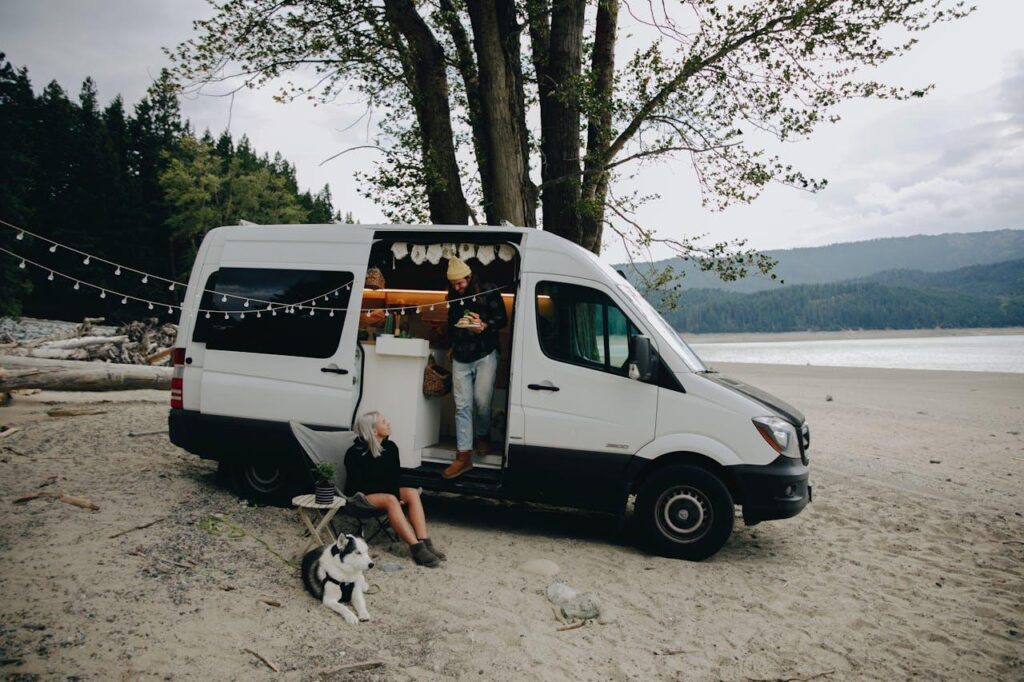Spring is an invitation to go outside into nature and just live life. The atmosphere signals camper owners to prepare for a new season of adventure. But before you hit the road, your camper needs a thoughtful transition out of winter hibernation. The randomness of spring is where some adventurers want to be extra cautious. That’s why paying attention to weather data is more than a forecasting habit. It allows a smarter outlook in the maintenance process of the camper. In this guide, we’ll walk through how you should prepare your camper for spring so that you thrive and enjoy your time in your mobile vehicle.
How To Maintain a Camper During Spring
These multiple steps are like a thumb rule to follow for setting your camper at the right tone.
#1 Dewinterize Your Camper
Enter your garage and prepare for the spring.
- Flush Up The Waterways: Open every faucet in your camper and even outside if you have one. The pink antifreeze might sputter out in spurts, but soon it clears. It’s like watching your camper stretch its limbs after a long slumber.
- Sanitize with Care: This step is more than hygiene, it’s peace of mind. Every 15 gallons of tank should require a 1/4th cup of bleach to clean every pipe.
- Let it sit. Hours, if not overnight. When you flush it clean, you’ll breathe easier knowing every drop that flows is safe.
- Reconnect the Essentials: Filters, drain plugs, the water heater element—each piece has a place, and each one matters. Especially the water heater. Never power it up dry; always give it the water it needs first.
#2 Check The Exterior
Out here, it’s the skin and bones—the armor your camper wears through storm and sun.
- Climb Carefully to the Roof: What you find might surprise you—tiny cracks like veins across sealant seams, or spots where UV rays have baked the surface brittle. Re-seal where needed with a self-leveling product. Trust the texture of the surface beneath your palms; it tells a story of wear.
- Inspect the Seams: Around every window, door, hatch, and corner lies the potential for water intrusion. Run your fingers along the caulk lines. If it’s shrinking or peeling, it’s time to reseal.
- Tire Check—No Corners Cut: Tires are often overlooked during RV checkups. If a blowout on a rural highway occurs, you will not forever remember it. So to avoid risks, check the PSI of your tire as it depletes 2 to 3 units each month. Look at the sidewalls for bulges and cracks. Run your hand across the tread. Feel any unevenness? That’s your cue.
- Give It a Bath: A thorough wash rinses away the salt and grime winter left behind. Follow with a coat of wax or UV protectant—think of it as sunscreen for your camper’s skin.
#3 Power and Battery Check Up
Without power, everything changes—from cold showers to spoiled food. Give these systems the spotlight they deserve.
- Reconnect Batteries: If they’ve been hibernating inside, clean their terminals first. A corroded terminal is like a clogged artery. Secure them in place and charge them fully. A voltmeter will give you truth, not hope.
- Propane System Check: Open valves slowly. Let your nose and a soapy water solution do the work—bubbles mean danger. Test every appliance: stove, water heater, furnace. Listen for the click, then the gentle whoosh of ignition.
- Test the Flow of Electricity: Plug into shore power and test each outlet, each switch, and each light. Walk slowly through your space. Touch everything. This isn’t busywork—it’s the heartbeat of your home-on-wheels.
#4 Interior Inspection
When the rain drums on the roof or wind howls through trees, this is where you’ll curl up. It deserves more than a quick tidy.
- Look for Signs of Life—Unwanted Ones: Mice, spiders, the occasional hornet. They find shelter easily. Check cabinets, corners, and behind drawers. Clean as you go, the space should feel fresh.
- Appliance Check: Fire up the fridge, the microwave, and the air conditioner. Wipe down filters. If something hums too loudly or smells off, shut it down and investigate. Machines have moods after a long nap.
- Safety is Non-Negotiable: Test your smoke alarm, CO detector, and propane sensor. These are quiet guardians—until they need to be loud. Replace batteries. Press buttons. Confirm their voice is still strong.
- Clean Deeply: Open every window and let spring flood in. Dust shelves, vacuum floor vents, and wipe down surfaces. Lingering odors from winter need an exit. Watch for mildew, especially in dark, damp corners.
- Restock Essentials: Your first-aid kit, flashlight batteries, paper goods, and go-to tools. Inventory your pantry. Pack the things you always forget, and a few you never want to be without.
Conclusion
During spring, new adventures are hard to miss and not to do. Your camper will transport you to memories that are waiting around the corner if you take good care of it today. If you have been camper driving for many years or if this is your first time, the process of taking care of your transport is crucial, and we have given you that solution. Cheers to the long, peaceful drives within the forest where high-altitude mountain peaks are peeping.

